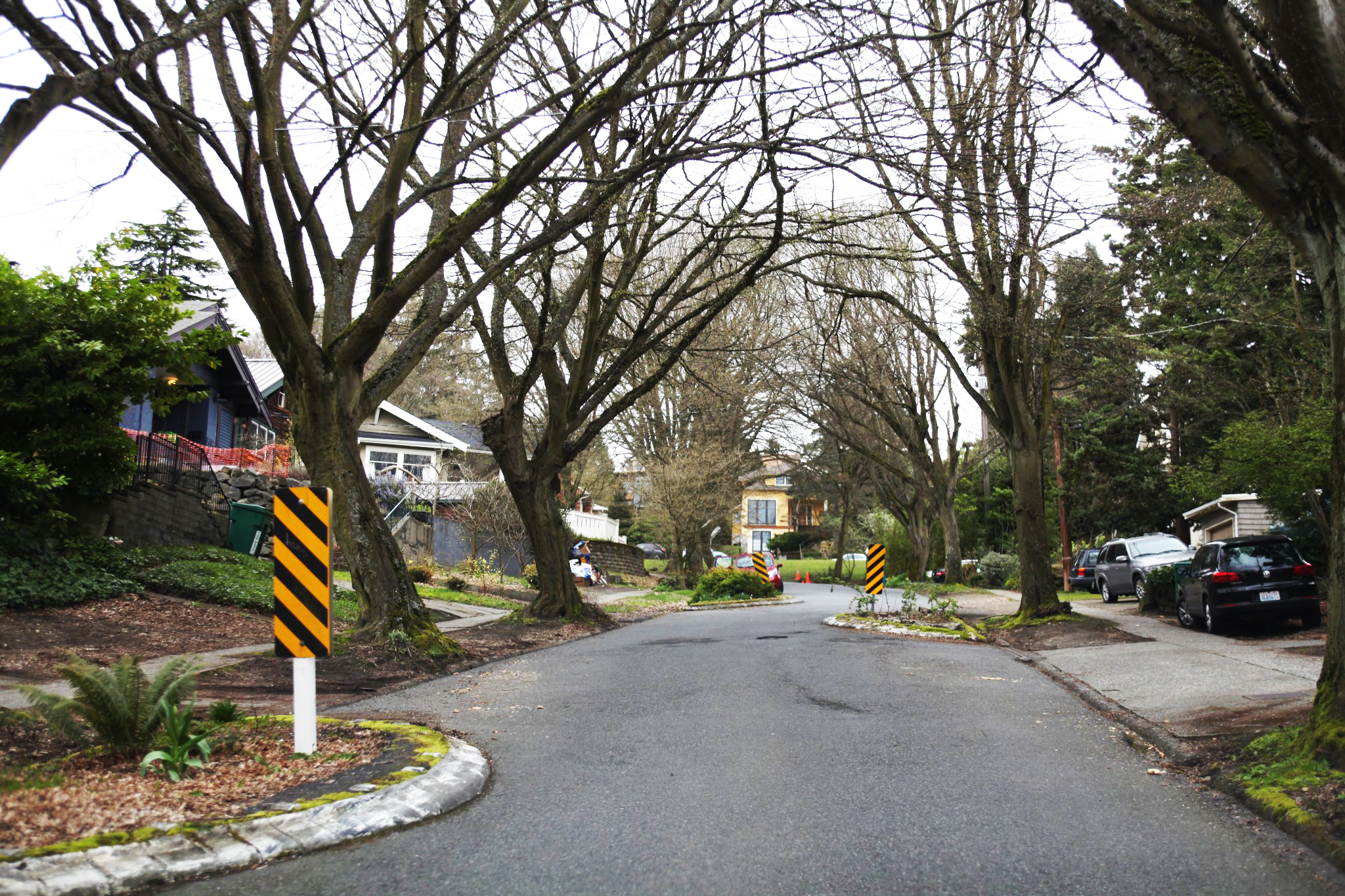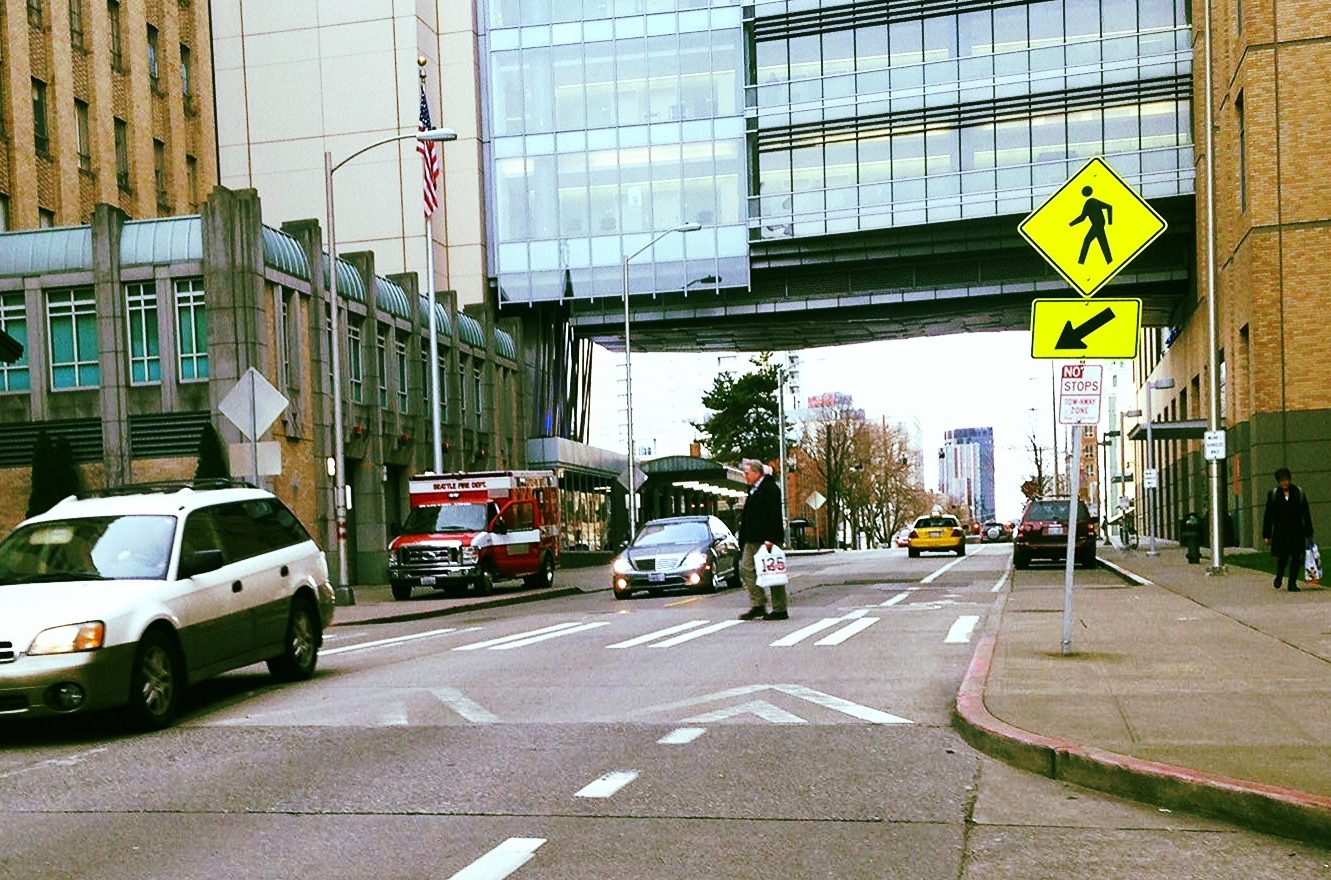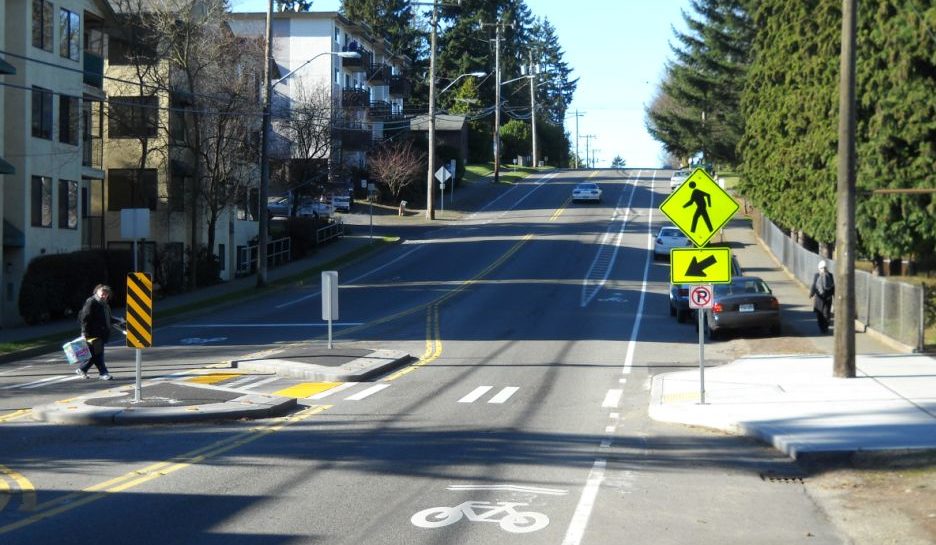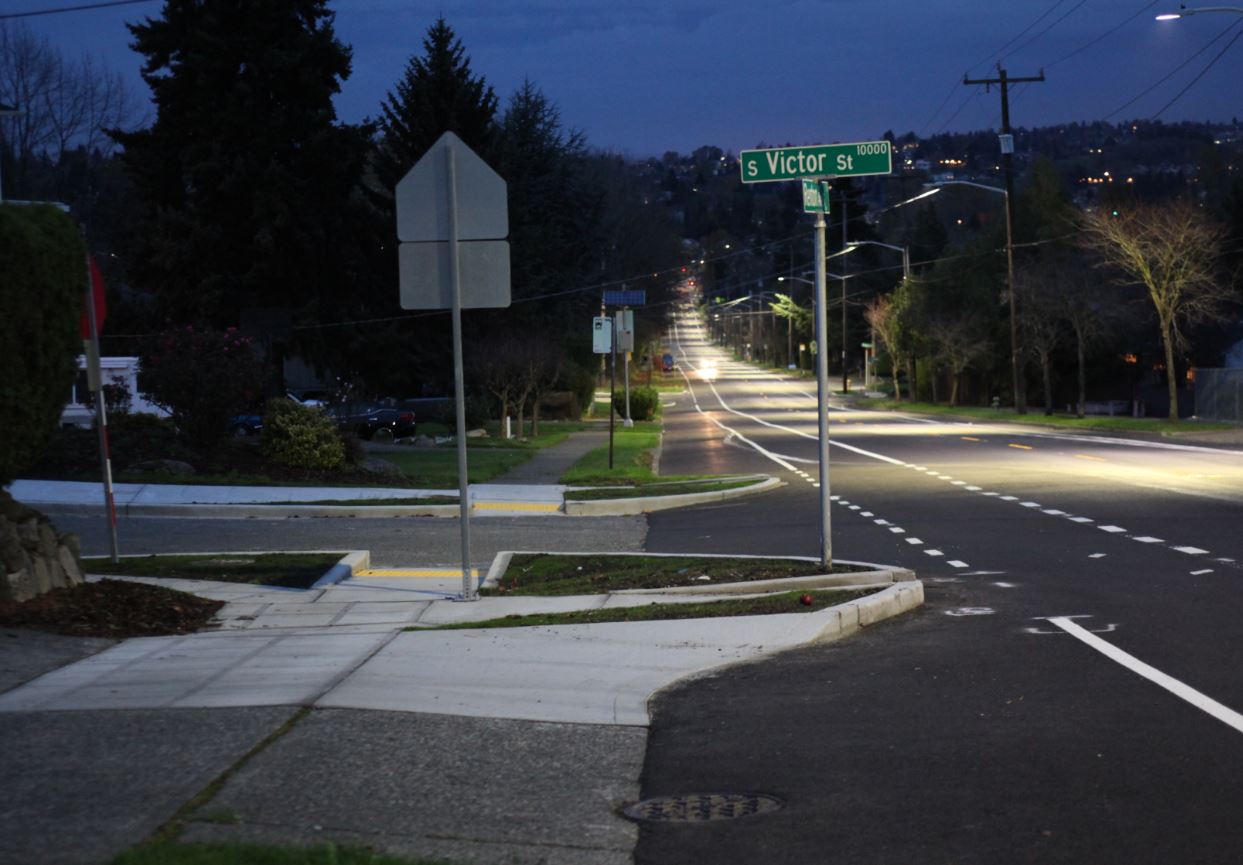3.12 Traffic Calming
Traffic calming has been used in many Seattle neighborhoods as a way to add design elements to improve safety and livability by reducing cut-through traffic, reduce speeds, and improve the environment for pedestrians.
Traffic calming relies on physical and visual cues in, and adjacent to, the roadway to encourage drivers to travel at slower speeds. Traffic calming is self-enforcing. The design of the roadway results in the desired effect, without relying on compliance with traffic control devices such as signals, signs, and enforcement. Street trees and lighting complement traffic calming devices and are often used to provide the visual cues that encourage people to drive more slowly and generally create a more livable neighborhood street.
Traffic calming is a powerful tool because it is effective. Some of the effects of traffic calming, such as fewer and less severe crashes, are clearly measurable. Others, such as supporting community livability and enhancing the pedestrian environment, are less tangible, but equally important. Research and experience has shown that traffic calming, if done correctly, reduces traffic speeds, and the number and severity of crashes. Traffic calming efforts are a key strategy to working towards Seattle’s Vision Zero goal of ending traffic deaths and serious injuries on city streets by 2030.
This section defines the Seattle Department of Transportation’s (SDOT) traffic calming policy, including appropriate tools for use on neighborhood streets.
Policy Guidance
Seattle’s Neighborhood Traffic Calming Program (NTCP) was established in 1978 as part of the City’s annual Capital Improvement Program (CIP). Since then, Seattle’s residents, in partnership with the City, have been involved in the installation of over 1000 traffic circles and other traffic calming devices on neighborhood streets. The purpose of these traffic calming efforts has been to reduce collisions and speeds on neighborhood streets, thereby creating safer, more pleasant neighborhoods. Traffic circles and speed humps are the most common tool used and can be seen in most residential neighborhoods throughout the City. SDOT’s NTCP is guided by specific goals and policies in the City of Seattle Comprehensive Plan Seattle 2035, such as:
- Comp. Plan Goal T6.9: Use complete streets principles, traffic calming, and neighborhood traffic control strategies to promote safer neighborhood streets by discouraging cut-through traffic.
- Comp. Plan Policy T6.1: Reduce collisions for all modes of transportation and work toward a transportation system that produces zero fatalities and serious injuries to attain the City’s Vision Zero objectives.
- Comp Plan Policy T6.2: Enhance community safety and livability through measures such as reduced speed limits, lane rechannelization, and crossing improvements.
Traffic Calming Goals
Consistent with the direction in the Comprehensive Plan, the City has established the following program goals to guide implementation of traffic calming:
- Traffic calming projects shall improve neighborhood safety and livability in balance with transportation and access needs of the community.
- Traffic calming efforts take a holistic approach to traffic management, resulting in streets that provide access to neighborhood destinations for all modes, including walking, bicycling, transit and automobiles.
- Traffic calming devices shall complement the overall transportation network and not result in shifting the problem to an adjacent residential, non-arterial street.
- Traffic calming projects should incorporate green stormwater infrastructure to optimize aesthetics and functionality of the facility.
Traffic Calming Guidance
Although traffic calming is typically used on Neighborhood Yield Streets, there are certain tools that are appropriate for use on other street types with arterial classifications (e.g. Downtown Neighborhood, Neighborhood Corridor, Urban Village Neighborhood, Urban Village Main, Urban Curbless). When a traffic calming approach is considered for any street, SDOT applies the following considerations:
- Vehicle speed is more critical than volume in terms of safety and should be addressed first where there are constraints. Treatments need to be spaced appropriately to have the desired effect on speed.
- Neighborhood involvement is important to successful implementation. Rationale for traffic-calming and management measures should be explained clearly to community residents and installation of these treatments should incorporate public input.
- Traffic-calming designs should be predictable and easy to understand by all people.
- Traffic calming measures should accommodate emergency vehicles, especially on non-arterial emergency routes. Emergency response times shall be taken into consideration during project review by SDOT and SFD. Refer to Street Type map to see if the street is on a primary emergency response route and therefore cannot include traffic calming devices.
- Traffic-calming measures prioritize bicyclists, pedestrians and people with disabilities. Pedestrian and bicycle movement should be balanced with vehicle movement in the design and implementation of arterial traffic calming projects.
- Traffic calming projects on street types with an arterial classification should not significantly impact freight or transit service access or safety.
- The area-wide street system should be considered so as not to divert traffic from one street to another.
Types of Calming Treatments
The City of Seattle has used a variety of traffic calming devices in locations deemed appropriate by SDOT in consultation with neighborhoods. Not all traffic calming devices or treatments are appropriate for use on every type of street or in every location.

Traffic circle
Traffic circles are used at uncontrolled or yield-control intersections to reduce speeds of motorists, which reduces collisions and improves bicycle and pedestrian safety. Traffic circle curb height shall not be higher than 4 inches for emergency vehicle access.
Considerations: Appropriate for consideration on Urban Village Neighborhood, Urban Village Neighborhood Access, Downtown Neighborhood Access, Minor Industrial Access, Neighborhood Yield, Neighborhood Curbless, and Urban Curbless street types. Special consideration should be given to those streets designed for emergency area access. Signs are discouraged in traffic circles to facilitate Emergency Vehicle circulation in the instance that they have to mount the curb; reflective tape should be used around the perimeter of the circle as an alternative.

Chicanes, chokers
Chicanes are three or more curb bulbs placed mid-block to narrow the roadway and/or create a winding travel path forcing motorists to reduce speed. Chokers/neckdowns are two curb bulbs placed mid-block directly opposite each other to physically and visually reduce the width of the roadway forcing motorists to reduce speed. Chicanes and chokers often narrow the travelway to a single lane, and encourage motorists to yield to oncoming traffic to pass before proceeding.
Considerations: Appropriate for consideration on Urban Village Neighborhood, Urban Village Neighborhood Access, Downtown Neighborhood Access, Minor Industrial Access, Neighborhood Yield, Neighborhood Curbless, and Urban Curbless street types. Chicanes and chokers may require the removal of on-street parking in spot locations. Chicanes and chokers should be designed to minimize impacts to storm water drainage.

Speed cushions
Speed cushions reduce vehicle speeds making streets safer for walking and biking. A speed cushion is a speed hump that has been divided into sections to allow vehicles with a larger wheel base (such as a fire truck or bus) to bypass them.
Considerations: Speed cushions are an appropriate traffic calming device on Neighborhood streets designated as emergency routes, Neighborhood Yield, Urban Village Neighborhood Access, Minor Industrial Access street types. Speed cushions are typically only considered on streets with posted speeds of 30 MPH or lower and lower traffic volumes. Speed cushions should be clearly marked with reflective markings and signs. The height of the speed hump should be tapered towards the gutter to allow for unimpeded bicycle movement.

Raised crosswalks and speed tables
Raised crosswalks employ vertical deflection that reduces speeds of motorists upon approach of the crosswalk. See the Pedestrian Crossing section for more information on design standards and guidance for raised crosswalks. Speed tables have a similar configuration as a raised crosswalk without the marked crosswalk in the center.
Considerations: Appropriate for use on Downtown Neighborhood, Downtown Neighborhood Access, Urban Village Neighborhood, Urban Village Neighborhood Access, Neighborhood Yield and Neighborhood Corridor street types. A raised crosswalk located at the transition to a residential street from an arterial is a good indicator of a change in land use, especially on streets designated as existing or future Neighborhood Greenways.
Raised intersections
Raised intersections are created by raising the roadway to the same level as the sidewalk, essentially creating a speed table across an entire intersection. This treatment enhances the pedestrian experience (particularly for people with mobility and visual impairments), reduces speeds of motorists, and increases visibility between motorists and pedestrians.
Considerations: Appropriate for consideration on Downtown Neighborhood, Urban Village Neighborhood, Neighborhood Corridor street types. Raised intersections are most appropriate in areas of high pedestrian demand.

Median Crossing Island
Crossing islands are raised areas placed in the center of the street at uncontrolled intersections or mid-block pedestrian crossings to protect pedestrians and bicyclists from moving traffic while they wait for an opportunity to cross the other half of the street. Crossing islands may narrow the street which encourages vehicles to reduce speeds and be more alert when approaching the pedestrian crossing.
Considerations: Appropriate for consideration on street types with an arterial classification (i.e., Downtown, Downtown Neighborhood, Urban Village Main, Urban Village Neighborhood, Urban Center Connector, Industrial Access).

Curb bulb
Curb bulbs are created by extending the sidewalk or curb line into the street at an intersection or mid-block crossing location (Standard Plan 432a) in order to shorten the crossing distance for pedestrians and improve visibility at crossing locations. By physically and visually narrowing the street, curb bulbs also have a traffic calming effect. See the Pedestrian Crossing section for design guidance for curb bulbs.
Considerations: Appropriate for consideration on street types with arterial and non-arterial classifications (Downtown, Downtown Neighborhood, Urban Village Main, Urban Village Neighborhood, Urban Center Connector, Residential Street, Neighborhood Street, Neighborhood Curbless, and Urban Curbless). Check the modal plan recommendations, particularly for Freight and Transit to ensure that the curb bulbs will not conflict with future or existing facilities and/or operations. In some cases, curb bulbs may also be integrated with bioretention to manage stormwater runoff from the right-of-way.
Other Street Design Strategies
Neighborhood greenways
Neighborhood Greenways are planned routes provided on lower volume, Neighborhood Yield or Neighborhood Curbless Streets designed to prioritize bicycle and pedestrian travel for people of all ages and abilities. Neighborhood greenways often incorporate traffic calming and other safety treatments to enhance comfort and safety for bicyclists and pedestrians.
Applicability/Considerations: Refer to SDOT’s Neighborhood Greenways website for more information on considerations.
Lane reduction/Lane narrowing
A typical rechannelization project reconfigures the street from four multi-purpose lanes to two multi-purpose lanes; a center left turn lane, and sometimes bicycle lanes. This lane combination can decrease vehicle collisions, reduce vehicle speeds, and improve safety for all travelers, particularly more vulnerable travelers (people walking and biking). Narrowing the width of the motor vehicle travel lanes allows right-of-way to be reallocated to other uses and has been shown to reduce motor vehicle speeds.
Considerations: Refer to the SDOT website for more information on rechannelization design for safer streets. Appropriate for consideration on all street types.
Gateway treatments
Public art, signage or other feature intended to create a visual cue that travelers are entering a special district or neighborhood.
Considerations: Appropriate for consideration on Neighborhood Corridor, Downtown Neighborhood, Downtown Neighborhood Access, Urban Village Neighborhood, Urban Village Neighborhood Access, Minor Industrial Access street types.
Streetscape improvements
Streetscape improvements, such as street trees, GSI, lighting, street furniture, and other elements enhance the bicyclist and pedestrian environment and slow traffic speeds by creating visual friction.
Considerations: Appropriate on all street types. For lighting and street furniture considerations, refer to Design Standards.
Other Speed Management Strategies
Radar Speed Sign
Radar Speed signs (also known as speed feedback sign or speed monitoring displays) are devices that use radar to detect and display the speed of passing motorists. These signs may be permanent or mobile and are typically placed where speeding is a recurring issue to raise awareness and encourage motorists to slow down.
Considerations: Radar Speed signs should be employed in areas where speeding is an issue but should not be a substitute for roadway design that encourages slower speeds. Radar Speed signs may be an interim strategy until more permanent design strategies are implemented, and may be appropriate on streets which have reduced speed limits. Radar Speed signs may be considered on all street types.
Speed limit reduction
Reduces the speed limit in order to slow traffic speeds.
Considerations: Appropriate for consideration on all street types. Roadway design and enforcement must be considered.
Process for Installing Traffic Calming
Refer to the Neighborhood Traffic Operations for more information on the process of implementing traffic calming devices or strategies on neighborhood streets. Learn more about the Vision Zero process for installing traffic calming or how to implement Safe Routes to School.
Adaptive Design Strategies
Adaptive design strategies (ADS) are temporary right-of-way improvements that provide quick, low-cost solutions for reallocating street space to address an opportunity or to mitigate an existing concern. See the Adaptive Design section for more information on adaptive intersection and mid-block treatments.
Landscaping for Traffic Calming Devices
Neighbors are responsible for the planting and maintenance of traffic calming devices after they are built. Landscaping is installed during the planting season (spring or fall). Plants are chosen based on their drought tolerance, resistance to occasional car traffic and street right-of-way landscaping guidelines, which promote visibility. Residents are responsible for the maintenance of traffic circle plantings, and several volunteers must be identified before the traffic circle is designed and constructed (see SDOT website). Replacement plants are not typically available through the NTCP, but access to free mulch and an invitation to the annual plant exchange is provided if you are registered with Urban Forestry. Funding for vegetation rehabilitation is available through the Department of Neighborhoods. The Seattle Department of Transportation recommends low-growing trees and plants (less than 24’’) for traffic circles and planting strips within 30 feet of an intersection. The suggested street tree planting list is located on the NTCP website. Refer to the Street Tree section and the SDOT Street Tree Manual for more information on landscaping.
